Grow bananas at home? Absolutely! Imagine stepping into your backyard and harvesting your own sweet, tropical bananas. It sounds like a dream, right? Well, it’s more achievable than you might think, and I’m here to show you how with some clever DIY tricks and hacks.
For centuries, bananas have been a staple food in tropical regions, deeply intertwined with the cultures and traditions of Southeast Asia, Africa, and the Americas. From ancient medicinal uses to symbolic representations of prosperity and fertility, the banana holds a special place in many societies. Now, you can bring a piece of that tropical heritage to your own home.
Why should you bother learning how to grow bananas at home? Well, beyond the sheer satisfaction of nurturing your own food source, you’ll also enjoy fresher, tastier bananas free from the chemicals and long transport times associated with store-bought varieties. Plus, it’s a fantastic way to connect with nature, learn about plant life cycles, and impress your friends and family with your green thumb! In this article, I’ll share simple, step-by-step DIY methods that even beginners can master, transforming your garden (or even your balcony!) into a mini-banana plantation. Get ready to embark on a fun and rewarding gardening adventure!
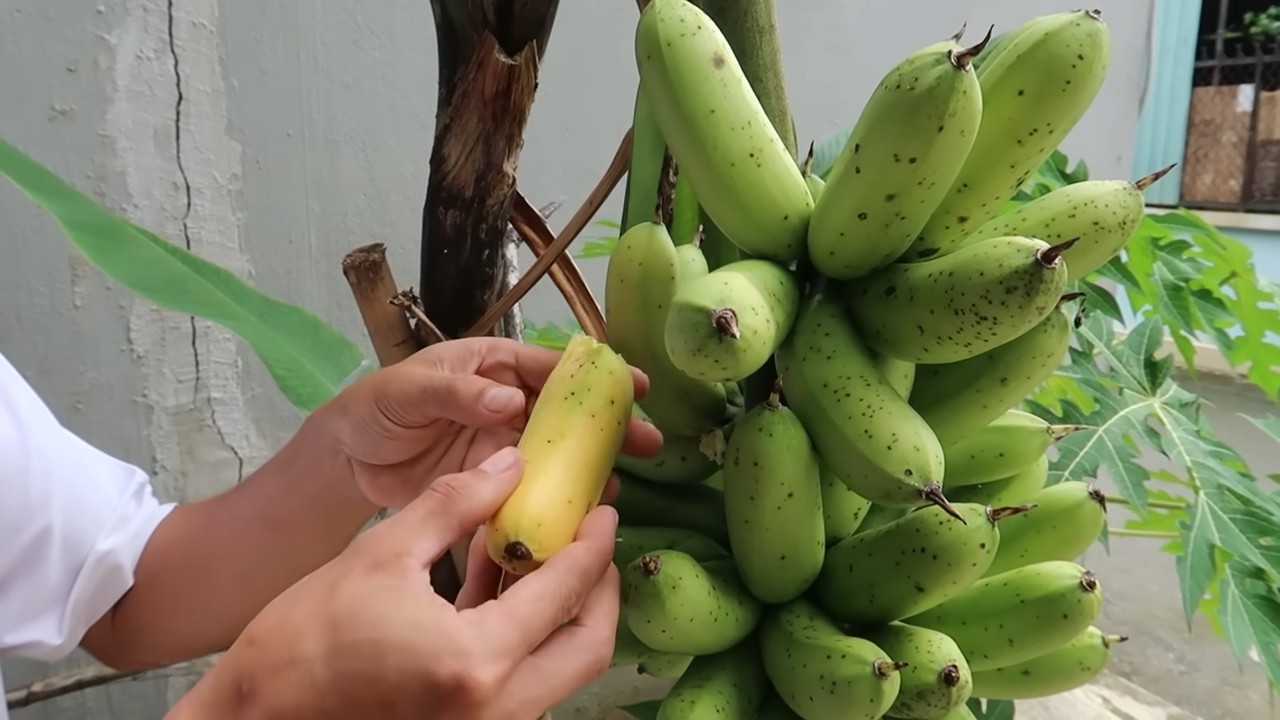
Growing Bananas at Home: A Tropical Treat You Can Cultivate Yourself!
Hey there, fellow plant enthusiasts! Ever dreamt of plucking a ripe, homegrown banana straight from your own backyard? Well, dream no more! Growing bananas at home is totally achievable, even if you don’t live in the tropics. It takes a little patience and know-how, but the reward of fresh, delicious bananas is absolutely worth it. I’m going to walk you through everything you need to know to get started.
Choosing the Right Banana Variety
First things first, not all banana plants are created equal. Some are better suited for home growing than others, especially if you live in a cooler climate. Here’s what to consider:
* Dwarf Varieties: These are your best bet for smaller spaces or container gardening. They typically grow to a manageable height of 6-12 feet. Popular choices include Dwarf Cavendish, Rajapuri, and Goldfinger.
* Cold Hardiness: If you experience occasional frosts, look for varieties known for their cold tolerance. Musa basjoo (Japanese Fiber Banana) is incredibly hardy and can survive temperatures down to 10°F, although it might not produce edible fruit in colder climates. Other options include Orinoco and Ice Cream (Blue Java).
* Fruit Quality: Of course, you want bananas that taste good! Research the flavor profiles of different varieties to find one that suits your palate. Cavendish bananas are the standard grocery store variety, while others offer unique flavors like vanilla (Ice Cream) or a slightly tangy taste (Goldfinger).
* Size of the Fruit: Some banana varieties produce larger fruits than others. Consider how many bananas you realistically want to eat and choose a variety accordingly.
Preparing for Planting
Okay, so you’ve picked your banana variety. Now it’s time to get your planting area ready. Bananas are hungry plants, so soil preparation is key!
* Sunlight: Bananas need at least 6-8 hours of direct sunlight per day. Choose a location in your yard that gets plenty of sun.
* Soil: Bananas thrive in rich, well-draining soil. Amend your soil with plenty of organic matter, such as compost, aged manure, or peat moss. This will improve drainage, aeration, and nutrient content.
* Drainage: Poor drainage is a banana plant’s worst enemy. If your soil is heavy clay, consider planting in a raised bed or container to improve drainage.
* Wind Protection: Banana leaves are large and can be easily damaged by strong winds. Choose a location that is sheltered from strong gusts, or provide some wind protection with a fence or other structure.
* Space: Even dwarf varieties need some space to spread out. Allow at least 6-8 feet between plants.
Planting Your Banana Plant
Alright, let’s get our hands dirty! Here’s how to plant your banana plant:
1. Dig the Hole: Dig a hole that is twice as wide and as deep as the root ball of your banana plant.
2. Amend the Soil: Mix the soil you removed from the hole with plenty of compost or other organic matter.
3. Plant the Banana: Carefully remove the banana plant from its container and gently loosen the roots. Place the plant in the hole, making sure the top of the root ball is level with the surrounding soil.
4. Backfill the Hole: Fill the hole with the amended soil, gently tamping it down around the plant.
5. Water Thoroughly: Water the plant deeply after planting to help settle the soil and establish the roots.
6. Mulch: Apply a layer of mulch around the base of the plant to help retain moisture, suppress weeds, and regulate soil temperature. Use organic mulch such as straw, wood chips, or shredded leaves.
Caring for Your Banana Plant
Now that your banana plant is in the ground, it’s time to provide it with the care it needs to thrive.
* Watering: Bananas need consistent moisture, especially during the growing season. Water deeply whenever the top inch of soil feels dry to the touch. Avoid overwatering, which can lead to root rot.
* Fertilizing: Bananas are heavy feeders and require regular fertilization. Use a balanced fertilizer (e.g., 10-10-10) every 2-3 months during the growing season. You can also supplement with organic fertilizers such as compost tea or fish emulsion.
* Pruning: Remove any dead or damaged leaves regularly. Once a banana plant has fruited, it will die back. Cut it down to the ground to make way for new shoots (called “pups”) to emerge.
* Pest and Disease Control: Bananas are relatively pest-resistant, but they can be susceptible to certain problems such as aphids, spider mites, and fungal diseases. Inspect your plants regularly and take action if you notice any signs of infestation or disease. Use organic pest control methods whenever possible.
* Winter Protection: If you live in a colder climate, you’ll need to protect your banana plant from frost and freezing temperatures. There are several ways to do this:
* Container Growing: If your banana plant is in a container, you can simply move it indoors to a sunny location during the winter.
* Mulching: Apply a thick layer of mulch around the base of the plant to insulate the roots.
* Wrapping: Wrap the trunk of the plant with burlap or other insulating material.
* Cutting Back: In very cold climates, you can cut the plant back to the ground and cover it with a thick layer of mulch. It will regrow from the roots in the spring.
Harvesting Your Bananas
The moment you’ve been waiting for! Harvesting your own bananas is incredibly rewarding.
* Timing: It takes about 9-12 months for a banana plant to produce fruit. The bananas are ready to harvest when they are plump and rounded, and the ridges on the fruit have started to disappear.
* Harvesting: Cut the entire bunch of bananas from the plant using a sharp knife or machete.
* Ripening: Bananas ripen best at room temperature. You can speed up the ripening process by placing them in a paper bag with an apple or banana.
* Enjoy! Savor the taste of your homegrown bananas! They’re delicious eaten fresh, or used in smoothies, desserts, and other recipes.
Growing Bananas in Containers
Don’t have a yard? No problem! You can still grow bananas in containers. Here’s what you need to know:
* Choose the Right Container: Select a large container with drainage holes. A 15-20 gallon container is a good starting size.
* Use a Well-Draining Potting Mix: Avoid using garden soil in containers, as it can become compacted and poorly drained. Use a high-quality potting mix that is specifically formulated for containers.
* Water Regularly: Container-grown bananas dry out more quickly than those grown in the ground. Water deeply whenever the top inch of soil feels dry to the touch.
* Fertilize Regularly: Container-grown bananas need regular fertilization to thrive. Use a balanced fertilizer every 2-3 weeks during the growing season.
* Provide Support: As the banana plant grows, it may need some support to prevent it from tipping over. Use a stake or trellis to provide support.
* Overwintering: If you live in a cold climate, you’ll need to move your container-grown banana plant indoors for the winter. Place it in a sunny location and water sparingly.
Dealing with Banana Pups
Banana plants produce new shoots, called pups, from the base of the plant. These pups can be used to propagate new banana plants.
* Removing Pups: Once a pup is about 1-2 feet tall, you can carefully remove it from the mother plant. Use a sharp knife or shovel to separate the pup from the mother plant, making sure to include some roots.
* Planting Pups: Plant the pup in a pot or directly in the ground. Water it well and keep it moist until it is established.
* Managing Pups: You can also leave the pups attached to the mother plant to create a clump of banana plants. This can be a good option if you have plenty of space. However, it’s important to thin out the pups occasionally to prevent overcrowding.
Troubleshooting Common Problems
Even with the best care, you may encounter some problems when growing bananas. Here are some common issues and how to address them:
* Yellowing Leaves: Yellowing leaves can be caused by a variety of factors, including overwatering, underwatering, nutrient deficiencies, or pests. Check the soil moisture and nutrient levels, and inspect the plant for pests.
* Brown Leaf Tips: Brown leaf tips are often caused by dry air or salt buildup in the soil. Increase humidity around the plant and flush the soil with water to remove excess salts.
*
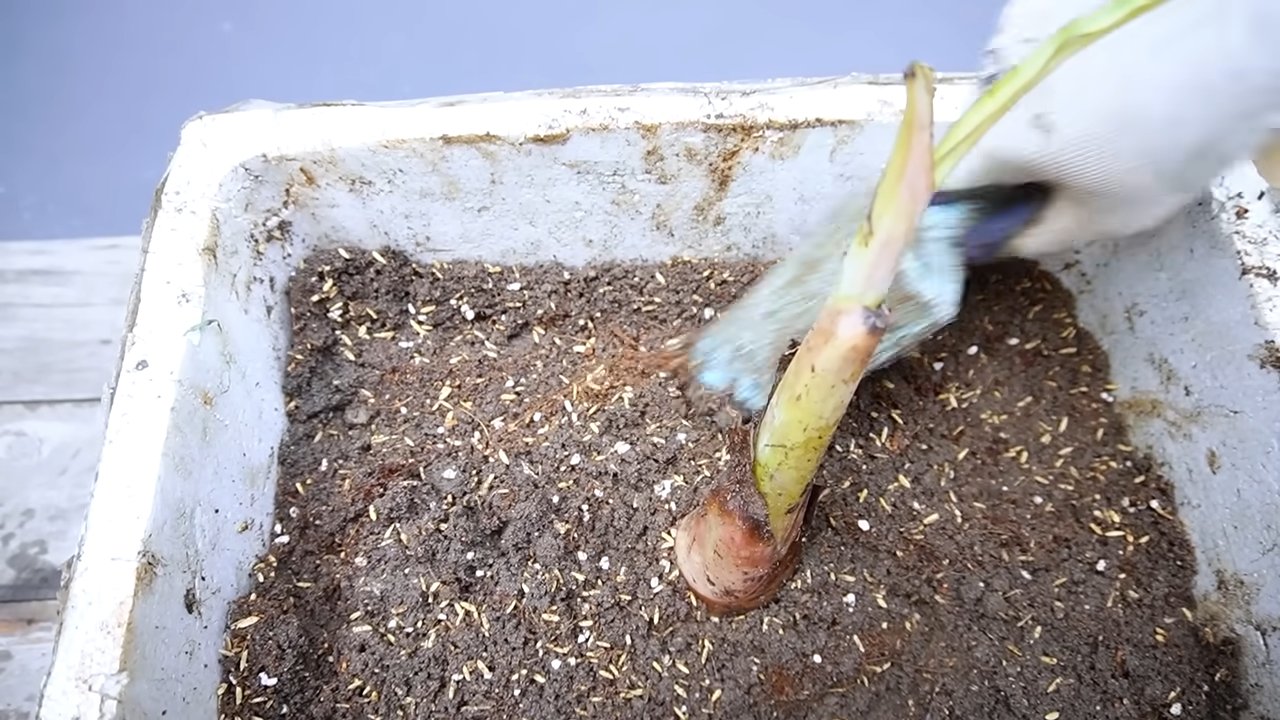
Conclusion
So, there you have it! Growing bananas at home, while it might seem like a tropical dream reserved for warmer climates, is entirely achievable with a little know-how and dedication. This DIY trick, focusing on creating the perfect microclimate and providing the necessary nutrients, opens up a world of possibilities, allowing you to enjoy the unparalleled taste of homegrown bananas right from your own backyard or even your balcony.
Why is this a must-try? Beyond the sheer novelty of cultivating your own tropical fruit, consider the benefits. You’ll have access to bananas free from the pesticides and long-distance transportation often associated with commercially grown varieties. You’ll be reducing your carbon footprint, contributing to a more sustainable lifestyle. And, perhaps most importantly, you’ll experience the immense satisfaction of nurturing a plant from a small sucker to a fruit-bearing beauty. The flavor difference alone is worth the effort – homegrown bananas boast a sweetness and creaminess that store-bought versions simply can’t match.
But don’t stop there! This DIY banana-growing method is incredibly versatile. Experiment with different banana varieties suited to container gardening, such as Dwarf Cavendish or Rajapuri. Try incorporating organic fertilizers like compost tea or banana peel tea to boost growth and fruit production. Consider companion planting with herbs like basil or mint to deter pests and enhance the overall health of your banana plant. You can even explore different mulching techniques to retain moisture and regulate soil temperature.
This isn’t just about growing bananas; it’s about creating a thriving ecosystem in your own space. It’s about connecting with nature and experiencing the magic of watching a plant flourish under your care.
We understand that embarking on this banana-growing adventure might seem daunting at first. That’s why we’ve provided a comprehensive guide, breaking down each step into manageable tasks. Remember to be patient, observant, and adaptable. Banana plants, like all living things, have their own unique needs and preferences. Pay attention to the signals they send, and adjust your care accordingly.
Now, it’s your turn! We wholeheartedly encourage you to try this DIY trick for growing bananas at home. Don’t be afraid to experiment, to learn, and to make mistakes along the way. The journey is just as rewarding as the destination. And most importantly, we want to hear about your experiences! Share your successes, your challenges, and your tips in the comments below. Let’s create a community of home banana growers, sharing our knowledge and inspiring others to embark on this exciting adventure. Show us your banana plants, your harvests, and your creative ways of incorporating homegrown bananas into your favorite recipes. Together, we can transform our homes and gardens into miniature tropical paradises, one banana at a time. So, grab your gardening gloves, prepare your soil, and get ready to experience the joy of growing your own delicious, homegrown bananas!
Frequently Asked Questions (FAQ)
1. What type of banana sucker should I use?
The ideal banana sucker is a sword sucker, which is a young shoot with narrow, sword-like leaves. These suckers typically have a well-developed root system and are more likely to thrive when transplanted. Avoid water suckers, which have broad leaves and a less developed root system, as they are less likely to produce fruit. Ensure the sucker is healthy and free from any signs of disease or pests. The size of the sucker can vary, but a sucker that is about 3-4 feet tall is generally a good starting point.
2. What is the best soil mix for growing bananas in containers?
Bananas thrive in well-draining, nutrient-rich soil. A good soil mix for container-grown bananas consists of equal parts:
* **Potting soil:** Provides a good base for drainage and aeration.
* **Compost:** Adds essential nutrients and improves soil structure.
* **Perlite or Vermiculite:** Enhances drainage and aeration, preventing waterlogging.
You can also add a slow-release fertilizer to the mix to provide a steady supply of nutrients. The pH of the soil should be slightly acidic to neutral, around 6.0 to 7.0.
3. How often should I water my banana plant?
Watering frequency depends on several factors, including the size of the container, the climate, and the stage of growth. Generally, banana plants need consistent moisture but should not be waterlogged. Water deeply when the top inch of soil feels dry to the touch. In hot, dry weather, you may need to water daily. In cooler, wetter weather, you can reduce the frequency. Ensure the container has drainage holes to prevent water from accumulating at the bottom.
4. What kind of fertilizer should I use for my banana plant?
Banana plants are heavy feeders and require a balanced fertilizer with a higher potassium content. A fertilizer with an NPK ratio of 10-5-20 or similar is ideal. Apply fertilizer every 2-3 weeks during the growing season (spring and summer). You can also supplement with organic fertilizers like compost tea, banana peel tea, or fish emulsion. Avoid over-fertilizing, as this can lead to salt buildup in the soil and damage the plant.
5. How much sunlight does a banana plant need?
Banana plants need at least 6-8 hours of direct sunlight per day to thrive and produce fruit. If you are growing your banana plant indoors, place it near a sunny window or supplement with grow lights. Insufficient sunlight can lead to stunted growth and reduced fruit production.
6. How do I protect my banana plant from frost?
Banana plants are sensitive to frost and can be damaged or killed by freezing temperatures. If you live in an area with cold winters, you will need to protect your banana plant during the winter months. If your banana plant is in a container, you can move it indoors to a warm, sunny location. If your banana plant is planted in the ground, you can wrap the trunk with burlap or blankets to insulate it from the cold. You can also mulch heavily around the base of the plant to protect the roots. In extremely cold climates, you may need to cut the plant back to the ground and cover it with a thick layer of mulch.
7. How long does it take for a banana plant to produce fruit?
The time it takes for a banana plant to produce fruit depends on the variety, the climate, and the growing conditions. Generally, it takes about 9-12 months from planting a sucker to harvesting the fruit. Some varieties may take longer, while others may produce fruit sooner. Proper care, including adequate sunlight, water, and fertilizer, can help to speed up the process.
8. How do I know when my bananas are ripe?
Bananas are typically harvested when they are still green but have reached their full size. The bananas will ripen off the plant. To determine if your bananas are ready to harvest, look for the following signs:
* The bananas will become plumper and rounder.
* The ridges on the bananas will become less prominent.
* The bananas will start to turn from dark green to a lighter green or yellowish color.
Once you harvest the bananas, you can ripen them at room temperature. You can speed up the ripening process by placing the bananas in a paper bag with an apple or banana.
9. What are some common pests and diseases that affect banana plants?
Some common pests that affect banana plants include aphids, spider mites, and nematodes. Common diseases include Panama disease, black Sigatoka, and banana bunchy top virus. Regular inspection of your banana plant can help you to identify and address any pest or disease problems early on. Use organic pest control methods whenever possible to avoid harming beneficial insects and the environment.
10. Can I grow bananas indoors if I don’t have a garden?
Yes, you can absolutely grow bananas indoors! Choose a dwarf variety that is well-suited for container gardening, such as Dwarf Cavendish or Rajapuri. Provide your banana plant with plenty of sunlight, water, and fertilizer. Ensure the container has drainage holes to prevent waterlogging. With proper care, you can enjoy the beauty and bounty of a banana plant even if you don’t have a garden.


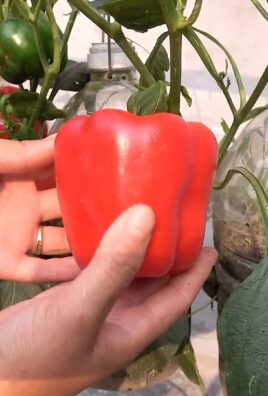
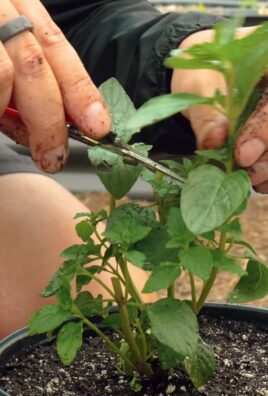
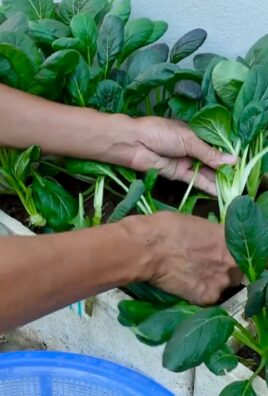
Leave a Comment